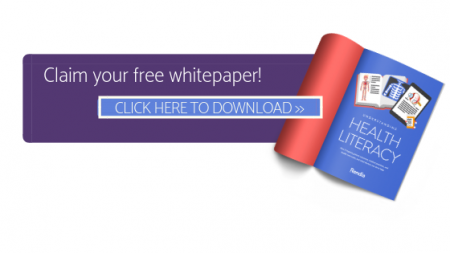The Patient Protection and Affordable Care Act defines health literacy as the “degree to which an individual has the capacity to obtain, communicate, process, and understand basic health information and services to make appropriate health decisions,” and unfortunately, low health literacy is a growing problem in today’s health care climate. According to the National Assessment of Adult Literacy, 22 percent of adults have only basic health literacy and 14 percent have below basic health literacy. And because health literacy is a strong indicator of health status, low literacy is linked with poor health outcomes and higher rates of hospitalization.
It is up to health care providers to ensure that patients with low health literacy are identified and given the tools they need to understand their options. But what can you do to overcome these obstacles and better communicate with your patients? The answer is effective and easy-to-understand patient education.
Lucky for you, we are here to help. October is health literacy month and the 2016 theme is “Be a Health Literacy Hero.” To help you be a hero to your patients, we have gathered together six tips to help you educate your patients and overcome the obstacles posed by low health literacy:
1. Start with the basics
According to the Journal of Health Economics, only 14 percent of Americans understand basic health insurance concepts. And this confusion leads to upset patients unwilling or too discouraged to engage in their care. Demystify coverage using an easy-to-understand and visually captivating video. Email “How Does Health Insurance Work?” to patients before they come in for an appointment.
2. Cater to different ages
Have you analyzed what kind of patients make up your patient base? Do you see many children? Or are you caring for an older generation? Patients differ based on their generation, and in order for your patient education to be relevant, it should reflect who is in your care as well as what kind of patients you are trying to attract. For example, if you are looking to increase the number of pediatric patients you see, you might want to spotlight videos geared toward a younger audience like “Balloon Sinuplasty (Pediatric).”
3. Be proactive
Don’t wait for patients to ask about a condition. Every month, try highlighting a medical issue that might be relevant to your patients, but they don’t know much about or understand. Highlighting these issues on a consistent monthly basis will help patients see you as a trusted, reliable source of health information. For example, we just released the video “Eyelid and Facial Spasms.” Sharing this video is just one way to clear up misconceptions and introduce treatment options, such as Botox, for anyone bothered by spasms.
4. Use the teach-back method
When your patient comes in for their exam, don’t just explain a condition and treatment and assume they understand. Give them the information then ask them to teach it back to you. This can help uncover any holes in their understanding. Couple this with educational information designed to be both straightforward and memorable. For example, try sharing a visually exciting but practical video such as “Something in Your Eye” and test out the teach-back method.
5. Encourage readiness
Checklists can save lives. At the very least, checklists and reminders can give you and your patients peace of mind. If they don’t understand something, have a question, or are worried they will forget something, a checklist can make all the difference. Ensure patients arrive ready for their visit to your practice with the tips in “Prepare for Your Appointment.”
6. Take advantage of holidays
The way you frame information will inform whether or not it will grab an audience’s attention. The Harvard Business Review puts it simply: “our biological, social, and personal experiences … lead us to embrace and pay attention to some ideas and to ignore others entirely.” Patients are more likely to pay attention to information if it is applicable to their daily lives. Popular holidays present the perfect opportunity to capture interest and bring up relevant issues with your patients. For example, with Halloween approaching, it is a great time for you to share our “Scary Contacts, Scary Consequences” video.
Want more pro-tips on addressing health literacy to increase patient engagement? Download your free copy of Understanding Health Literacy today!


